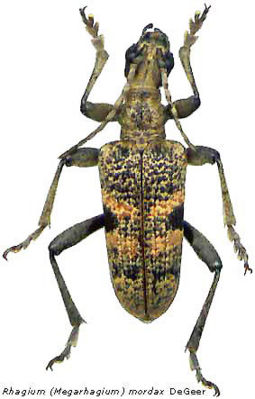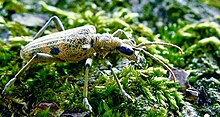Black-spotted pincer buck
| Black-spotted pincer buck | ||||||||||||
|---|---|---|---|---|---|---|---|---|---|---|---|---|

Black-spotted pincer buck ( Rhagium mordax ) |
||||||||||||
| Systematics | ||||||||||||
|
||||||||||||
| Scientific name | ||||||||||||
| Rhagium mordax | ||||||||||||
| ( De Geer , 1775) |
The Schwarzfleckige pliers Bock ( Rhagium mordax ) is a beetle of the family of longhorn beetles (Cerambycidae). The species is also known as the snappy tong buck , hardwood tong buck or shot tong buck .
features
The beetles reach a body length of 13 to 22 millimeters. The wings (elytres) are dark and have two light, yellow-red transverse bands. The top of the animals is drawn with a light toment. In almost all individuals there is a momentless spot on the side of the wing behind the front transverse band. The antennae are short and reach just past the base of the wing panels. The temples are at least as long as the compound eyes . The species differs from the oak pincer buck (Rhagium sycophanta) by its characteristic bulge between the shoulder and the scutellum , which the black-spotted pincer buck is missing. The bald spot behind the front transverse band is also missing in the similar species.
Occurrence and habitat
The species is common in Europe and Asia. It occurs in Europe up to the far north and also on the British Isles. The beetles live in forests from the plains to the mountains. In southern Europe the species is found up to the Mediterranean coast, where it colonizes higher altitudes.
Way of life
The beetles appear from May to August. On sunny days they can be found especially on tree stumps and on the flowers of umbellifers . The larvae develop in trunks and stumps of various deciduous trees, such as oak ( Quercus ), beech ( Fagus ), birch ( Betula ) and linden ( Tilia ). Softwood is also rarely colonized. Pupation takes place in a cradle under the bark. The adults hatch in autumn, but still overwinter in the doll's cradle. They need two years for their development, in higher altitudes three years.

|
|
| Doll of the ram in doll's cradle (silver fir) | |

|

|
| Freshly hatched, not yet colored | |

|
|
| Same animal 2 days later | Side view |

|
|
| Front view, beetle gnawing on bud | |
supporting documents
Individual evidence
- ^ A b Karl Wilhelm Harde , František Severa : Der Kosmos-Käferführer. The Central European beetle . Franckh-Kosmos, Stuttgart 2000, ISBN 3-440-06959-1 , p. 264 .
- ↑ a b c d Jiři Zahradnik, Irmgard Jung, Dieter Jung et al .: Beetles of Central and Northwestern Europe: an identification book for biologists and nature lovers . Parey, Berlin 1985, ISBN 3-490-27118-1 , pp. 251 .
literature
- Karl Wilhelm Harde , František Severa : The Kosmos Beetle Leader. The Central European beetle . Franckh-Kosmos, Stuttgart 2000, ISBN 3-440-06959-1 .
- Jiři Zahradnik, Irmgard Jung, Dieter Jung et al .: Beetles of Central and Northwestern Europe: an identification book for biologists and nature lovers . Parey, Berlin 1985, ISBN 3-490-27118-1 .
